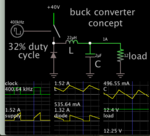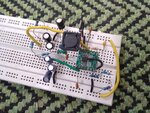vimalraj
Junior Member level 2

Hi,
I am using TPS54560 buck converter IC for my project this is the first time.
Vin=20v-60v, Vout=12V, Iout=5A, Fsw=400KHz this is my design parameter. I am getting 12.6V as output when no load is connected. After I connect 0.5A load, the output voltage is suddenly dropped to 3v.

I have tried many possibilities but none of it gave me a good result, at last, I am here
Kindly give me a solution
Thank you.
I am using TPS54560 buck converter IC for my project this is the first time.
Vin=20v-60v, Vout=12V, Iout=5A, Fsw=400KHz this is my design parameter. I am getting 12.6V as output when no load is connected. After I connect 0.5A load, the output voltage is suddenly dropped to 3v.

I have tried many possibilities but none of it gave me a good result, at last, I am here
Kindly give me a solution
Thank you.






